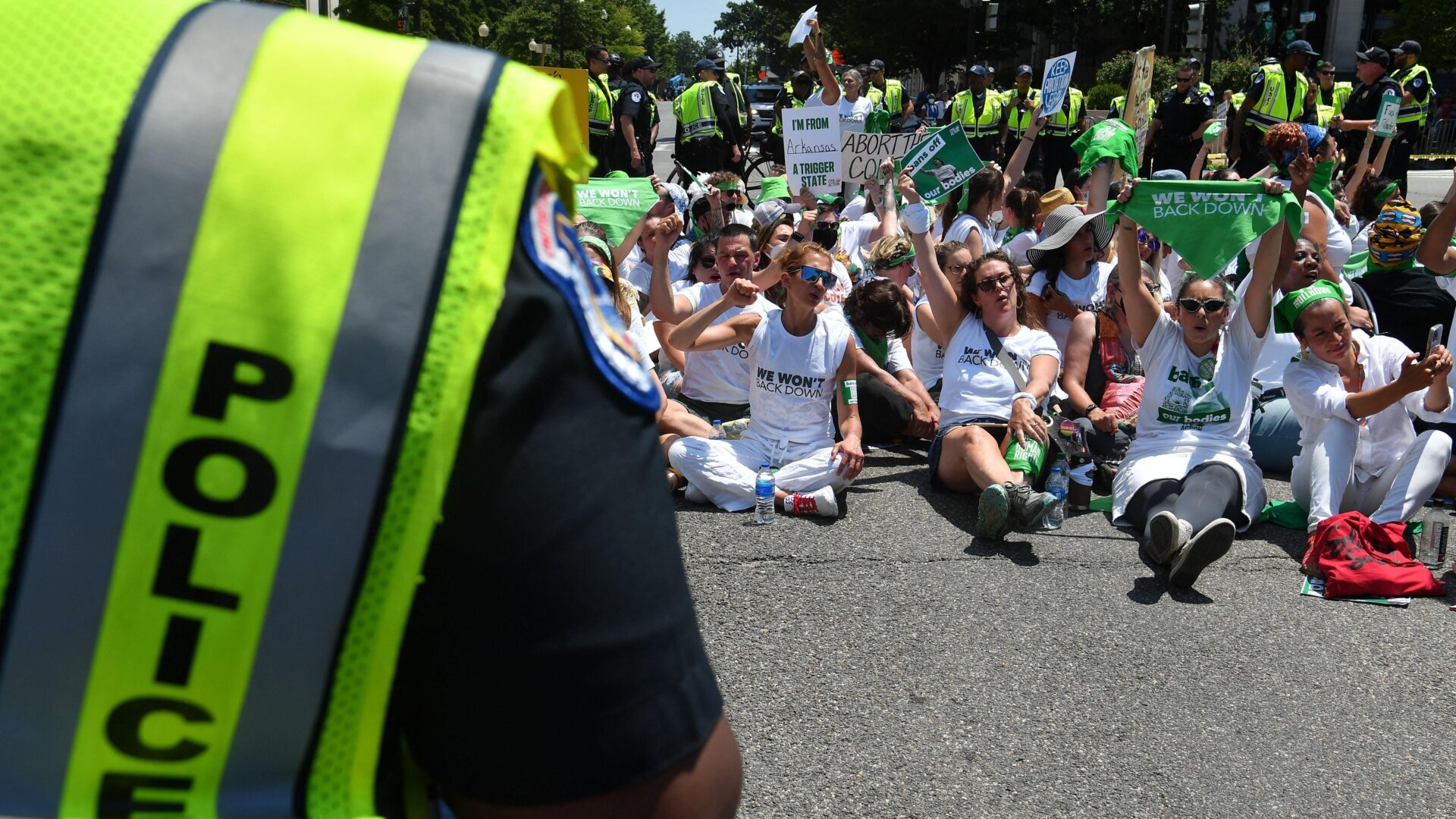Jose Herrada, an inmate at Florida’s Gulf Correctional Institution, first heard news about Hurricane Michael on the radio. Initially, Herrada thought little of it. Although the state of Florida had issued a mandatory evacuation order for nearby Panama City and surrounding areas, officials at Gulf CI hadn’t brought up the possibility of evacuating the prison’s 1,500 inmates. Herrada assumed that meant he would be safe.
“We thought [the hurricane] was not coming close when they did not evacuate us,” Herrada told Earther by email.
If officials at Gulf CI reached a similar conclusion, they were dead wrong. The prison took a direct hit from Hurricane Michael as the historically-powerful storm surged across the Florida Panhandle on October 10th. The damage to was immediate: The facility lost power, and phone lines stopped working. Water started flooding in through cracks along the windows. The wind was so strong that it cleaved off several dormitory roofs and a section of the perimeter fence, according to Herrada and The Miami Herald, and inmates had to rush to keep their belongings dry as water flooded in. Buzzfeed reported that many dorm rooms were destroyed and that some windows were entirely blown off.
“We were scared,” Herrada told Earther. “Most of us are scarred emotionally. I myself have nightmares.”
Although the Florida Department of Corrections evacuated six prisons prior to Hurricane Michael’s arrival, Gulf CI is one of a number in the path of the storm were not evacuated in advance. Four days after the storm, on October 14th, Gulf CI and other hard-hit prisons were fully evacuated “until further damage assessment can be completed,” per the department.
Michelle Glady, a spokesperson for the Florida Department of Corrections, told Earther the department makes determinations about what facilities should be evacuated in the “best interest of public, staff and inmate safety” based on “wind speed, flooding history, building age, road safety,” and other factors. Glady added that “much like many North Florida communities, our facilities sustained damage” but, in all prisons, “our staff and inmates were safe, and no one was injured during the storm.”
Herrada takes a different view. “They took a gamble with our lives,” he told Earther.
In recent years, a spate of mishandled hurricanes has exposed the failures of the U.S. prison system to account for those it incarcerates during natural disasters. The problem was on full display during the two most destructive hurricanes of 2018. A month before Michael, in September, Hurricane Florence bore down on the Carolinas. While North Carolina and Virginia evacuated prisons under threat, the South Carolina Department of Corrections refused to evacuate facilities that lay within high-risk zones.
And climate change, which expected to produce bigger and deadlier storms, could place already-vulnerable incarcerated people in even greater danger. That’s not only because their personal safety is consistently ignored during storms, but also because prisons themselves are often at greater risk from hurricanes than other housing structures.
According to Yale researcher Hannah Hauptman, who mapped out prison geographies in a recent paper, prisons are disproportionately located on low-lying land that remains vulnerable to storm impacts, in part because many U.S. prisons are former slave plantations. “The state approves of and constructs prisons significantly closer to dangerous floodplains than it does for other forms of settlement,” Hauptman notes.
Even today, private companies sometimes fail to consider storm risks when choosing the locations for new prisons. Washington’s Northwest Detention Center, which opened in 2004, houses up to 1,575 immigrants in one of the nation’s riskiest tsunami zones. In the event of a tsunami, according to The Seattle Globalist, the prison “will fill with as much as two meters of water in less than eight minutes.” (Northwest Detention Center did not immediately return Earther’s request for comment.)
“We tend not to prioritize the needs of people who are incarcerated,” Keramet Reiter, a professor of criminology at the University of California Irvine School of Social Ecology, told Earther. “In a disaster they are maybe the last priority.”
The problem is deeply entrenched, beginning with the fact that many prisons do not even have clearly stated emergency evacuation plans during natural disasters, and there is no state or national requirement that they do, as noted in a recent paper by Columbia Law student William Omorogieva. (Some states require other forms of emergency planning, but none mandates plans specific to natural disasters.)
Shaundra Young Scott, director of the ACLU in South Carolina, told Earther that part of the issue is funding. Evacuations are expensive, and in South Carolina, where the state has already “slashed” mental health programs in its prisons in the last eight years, “it’s pretty clear the state legislature is loath to spend money on prisoners, and quite frankly, they aren’t worried about evacuation because they don’t care about prisoners.” When voters also tend to lack empathy for people in prison, there is no political will to change the system.
Reports of inmates stranded by devastating hurricanes date back to at least 1937, when the Kentucky state reformatory broke into riots after days without drinking water. Following Hurricane Katrina, New Orleans prisoners who were not evacuated smashed windows to let air in as the floodwaters rose, and they lit their shirts on fire so aid workers would know they were trapped. Last year, during Hurricane Harvey, Houston inmates in multiple prisons were left in cells “flooded knee-high with water contaminated by urine and feces” without enough food or drinking water, according to The Nation.
Texas inmate Deidre McDonald wrote for The Marshall Project about waking up to the sound of thunder cracking and officers screaming for everyone to get to the second floor the morning that Harvey made landfall. Though the state had issued an evacuation warning for Dickinson, Texas, where she was held, the prison did not relocate the group of predominantly disabled inmates living there. McDonald noted that her prison—like so many others—was structurally unequipped for a dangerous hurricane: “Given the way the Texas Department of Criminal Justice built this place, the sidewalks overflow during even the lightest rain, creating a constant slip-and-fall hazard for the predominantly disabled offender population here,” McDonald wrote.
Last year, after Hurricane Irma struck her 700-person Miami prison, Homestead Correctional Institute, inmate Natalie Price went two weeks without power. Around her, people were crammed three to a room. Two inches of water lined the floors, Price told Earther, and more leaked in through the walls. All things considered, Price feels the prison administration “handled things well for our state emergency”—most of the problems, she said, came not from the administration but from the old age of the buildings, which were prone to leaks.
Most of the families of inmates around her also didn’t understand what was happening, according to Price. Although the state notified them that the Homestead Correctional Institute would be evacuated, it never was.
This fall, even Florida prisons located further from the shore than Gulf CI—like Apalachee Correctional Institution, which houses up to 1,300 people—felt the effects of Hurricane Michael. Michael Henderson, an inmate at Apalachee CI, told Earther that the prison is so old that even before Hurricane Michael, some windows were broken or outright missing.
When the storm arrived, rain rushed in through the open windows, and inmates scrambled to salvage their belongings. “For some of us, like myself that meant vital legal work that if destroyed would have left me at a major disadvantage,” Henderson said. Yet the worst part was not the flooding itself but the unrest after. Inmates were stuck in lockdown and unable to leave their dorms, Henderson said, recalling that they ate only cold sandwiches served at odd hours.
On October 14th, four days after Hurricane Michael, the dorm across from Henderson’s “broke into a full on free for all” that resulted in officers armed with tactical gear detaining inmates. “About thirty men were removed and taken to confinement or transferred,” Henderson said. (Apalachee CI did not respond to Earther’s request for comment on this incident, but verified a “near riot” over food to the Florida Times Union in October.)
“The officials knew this hurricane was coming and did little to prepare,” Henderson added.
The systemic failures of the prison system to account for the people it incarcerates during major storms has not escaped the notice of inmates. Before a hurricane, more experienced inmates often warn newer ones about the unique dangers they face.
Back at Gulf CI, Shamar McCullum, another inmate, calls this “the talk.” McCullum told Earther that a group of older inmates sat him and others down before the storm and warned them that officers may leave to save themselves; that after the hurricane, each person should “eat light”; and that each inmate should save his most valuable property because it may get “flooded out.” (According to McCullum, the last two concerns proved to be true.)
McCullum also told Earther that, in the immediate aftermath of Hurricane Michael, he had little access to drinking water because the pipes burst. Food came infrequently—on the third day, he was fed only one meal. McCullum recalls that when an inmate asked an officer when their meal was coming, the officer responded, “Better hope you even get feed at all.” “That’s when I knew it was not looking good for us,” McCullum said.
Inmates who asked to be seen by nurses were refused and threatened with disciplinary reports because of the lockdown, according to McCullum. He and the other inmates had no way of communicating with their families, though Gulf CI did relay a message that everyone was ‘OK,’ McCullum said. They spent long days sitting in their cells without possibility of leaving.
When presented with these allegations the Florida Department of Corrections told Earther that although it could not confirm or deny individual claims, “all inmates had access to food and drinkable water” and “medical needs were addressed and prioritized, and inmates have access to routine care.”
Only two days after Hurricane Michael made landfall, Gulf CI was reduced to such disrepair that the first set of inmates were finally evacuated. Adam Baird, a Gulf CI inmate, said that when the evacuation order finally came, many inmates had gone a day without food. “50 or 60 officers came in around 10:30 pm and told everyone to grab their toothbrush, toothpaste, soap, and deodorant, and tie the rest of our property in a sheet and leave it in the cell,” Baird told Earther, recalling the evacuation.
McCullum, for one, was relieved. “Now that it is all over I still find myself day dreaming about just how bad things could have been if I stayed one more day at that place,” he said. “What I and the others went through is a experience I don’t want anybody that’s locked up to go through because officers don’t care about inmates, especially at the time of a hurricane.”
McCullum and the other Gulf CI inmates have been moved to a patchwork of neighboring prisons, including Mayo CI and the Northwest Florida Reception Center. They do not know when—or if—they will return to Gulf, but because of the damage, they don’t expect it will be anytime soon. (Maintenance crews are currently working on repairs, according to the Florida Department of Corrections.)
Whether their experiences will propel policy changes remains to be seen. Some researchers, like Omorogieva of Columbia Law, have proposed that FEMA create a special coordinator for incarcerated populations who could craft new requirements to evacuate inmates during natural disasters. There is even a mechanism for doing this: Congress could expand the Post-Katrina Emergency Management Reform Act of 2006, which created a Disability Coordinator within FEMA, to also address the needs of incarcerated people.
But that requires political will. And although during this year’s National Prison Strike incarcerated activists highlighted the importance of environmental issues, and a disparate group of protesters convened outside the South Carolina State House to demand evacuations during Hurricane Florence, few lawmakers have even acknowledged the risks that incarcerated populations face during major storms.
Michael Waters is a freelance writer and a junior at Pomona College.














